How to make fresh pasta with Theo Randall
Learn how to make homemade pasta using celebrity chef Theo Randall's signature recipe...
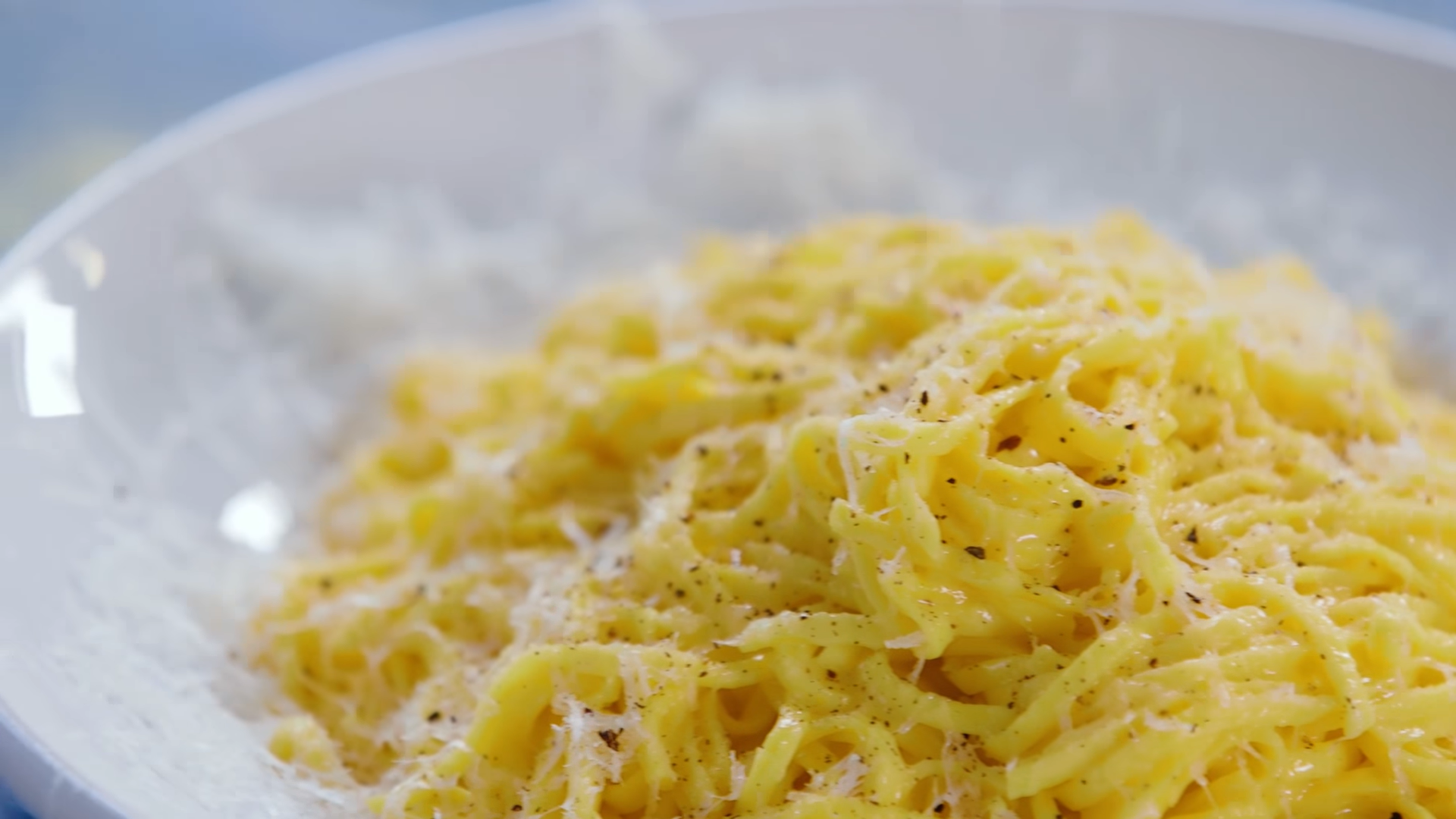

Christina Geggus
Like to try making your own pasta? Chef Theo Randall shares his delicious homemade pasta recipe along with expert tips on how to make sure it is light in texture but rich in flavour.
Learn how to make lasagne sheets, tagliatelle, or taglierini with Theo Randall's homemade pasta recipe. In this step-by-step guide, Theo expresses the importance of making sure your eggs are organic and yolks are a nice colour, so that your pasta has a fresher taste and has beautiful yellow colour. He also says that Tipo '00' flour is a must in this recipe, not plain flour.
The reason why Theo uses Tipo '00' flour is that it is an extremely fine durum wheat flavour, which is what is typically used to make pasta. There are a few variations when it comes to pasta recipes across the world, with some chefs using the traditional way of a mixture of Tipo '00' flour and semolina flour, as well as whole eggs and egg yolks. Some chefs do omit the eggs entirely and use just a mix of flour and water, but this is the kind of recipe you tend to find in delis and grocers because, without the egg, it is easier to preserve. However, if you want to make pasta the true Italian way, follow Theo's instructions.
Theo also suggests when using the pasta maker, that you should only prove your pasta around 5-6 times, as otherwise, the pasta will become dry. Then after you have put it through the finer setting, your pasta should be a nice elasticity and should not break and be silky in texture, so that you can see the outlines of your hand through it.
Preparation: As fresh pasta is all about being super fresh, very little preparation is needed for this recipe. Although this recipe is catered for those with a pasta maker, if you see below, we have a section about how you can do this recipe without one. You only need to make sure that you have a deep saucepan so that you can cook your delicious fresh pasta straight away.
Therefore, the only preparation needed for this recipe is to make sure you have dampened a tea towel before starting, as this will help to keep the pasta from drying out and is used throughout the recipe.
Theo also finishes off his recipe with his choice of Parmesan which can be grated before you start the recipe, along with any truffle mushrooms.
GoodtoKnow Newsletter
Parenting advice, hot topics, best buys and family finance tips delivered straight to your inbox.
Watch Theo Randall make homemade fresh pasta
Ingredients:
- 350g ‘00’ pasta flour
- 25g semolina flour, plus extra for dusting
- 2 whole eggs
- 4 egg yolks
How to make fresh pasta
Step 1
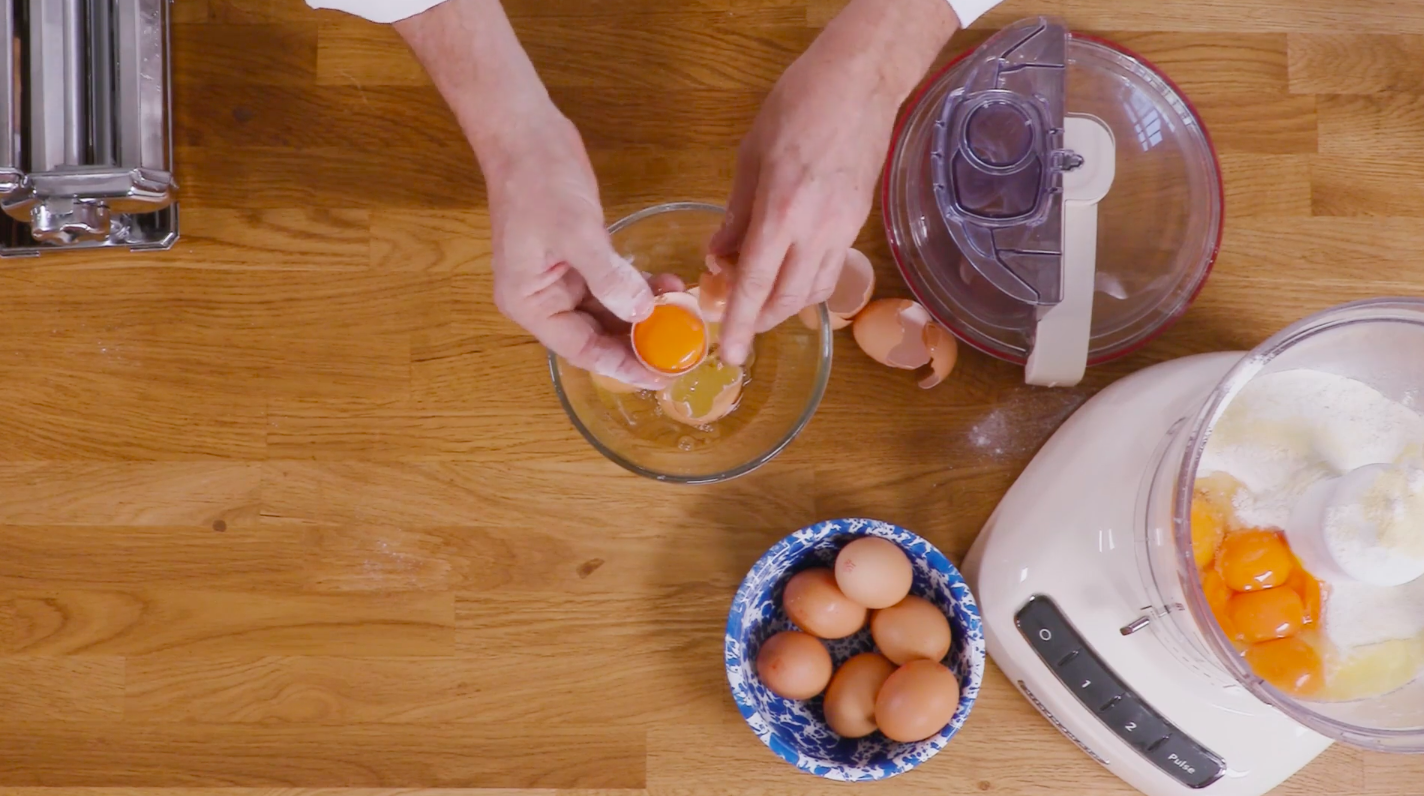
Mix all the ingredients, plus 1tsp water in a food processor and blitz until well formed.
Step 2
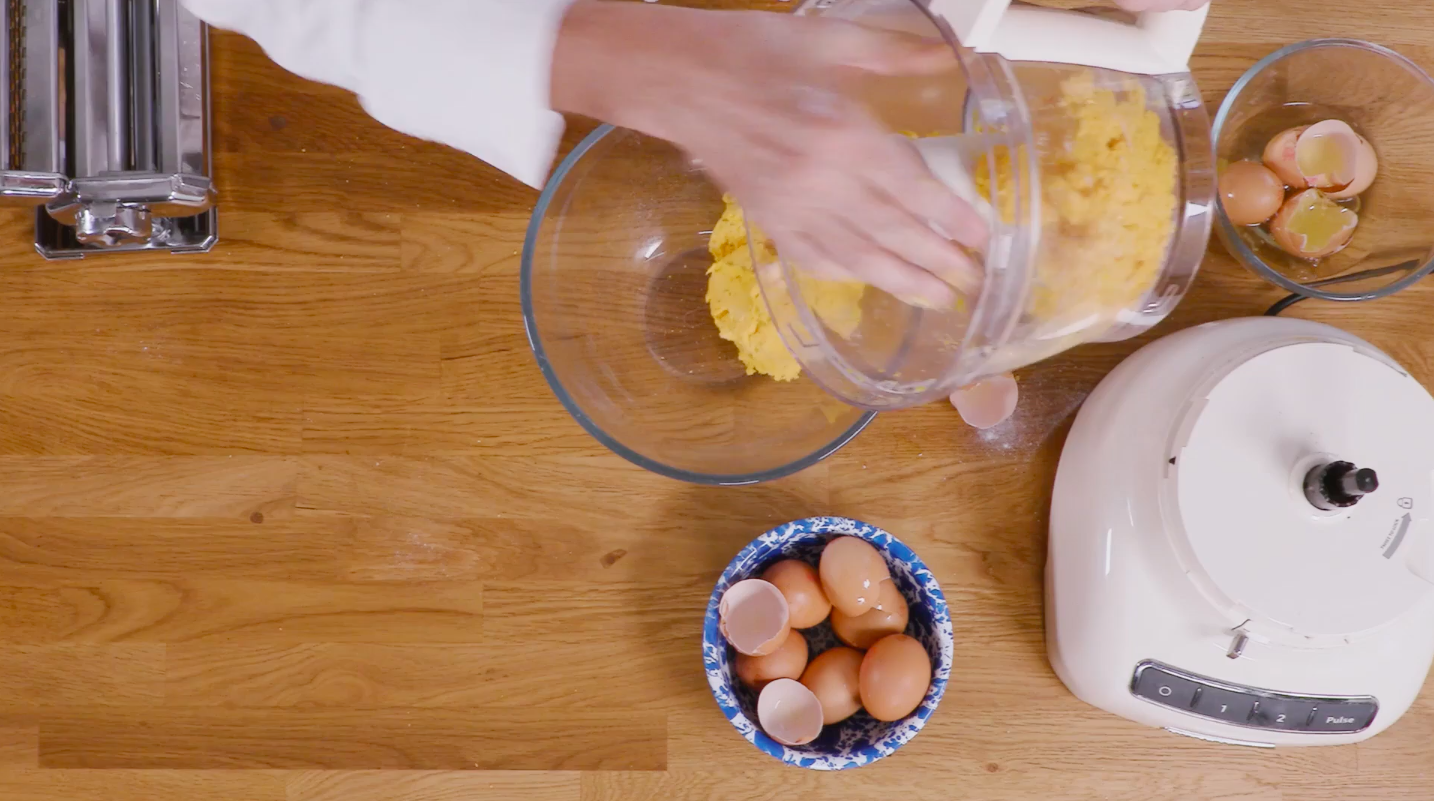
You want the texture to be that of plasticine, so add a little more water if it feels too dry. If you don’t have a food processor then you can do this by hand. Simply make a mound from the flour on a flat surface. Make a well in the centre and add the eggs to the well. Slowly begin to bring the dough together in the centre, gradually pulling all the flour in as you go.
Once your dough has been brought together, by hand or in the food processor, tip on a clean surface and knead until smooth and silky.
Step 3
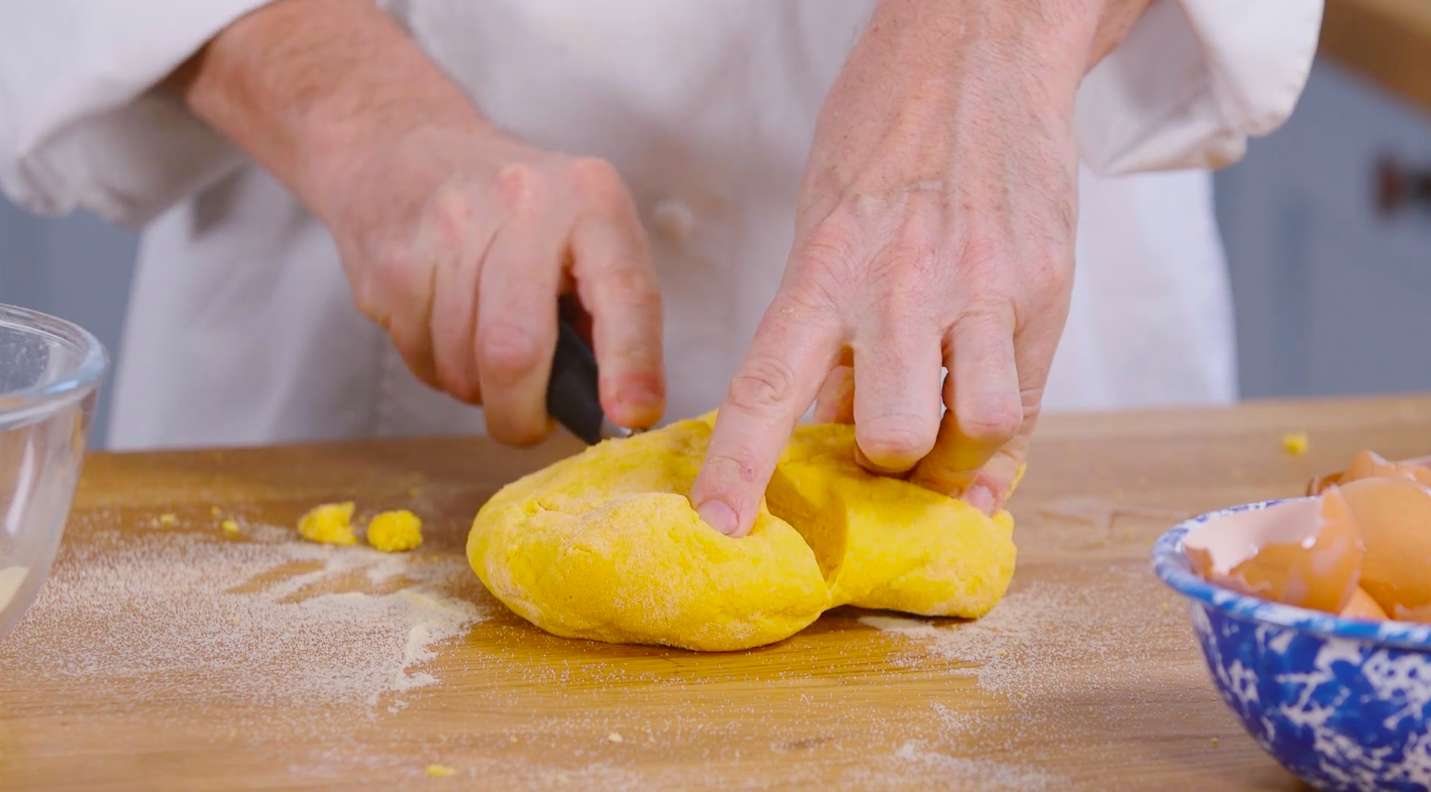
Divide the mixture into 4 balls.
Step 4
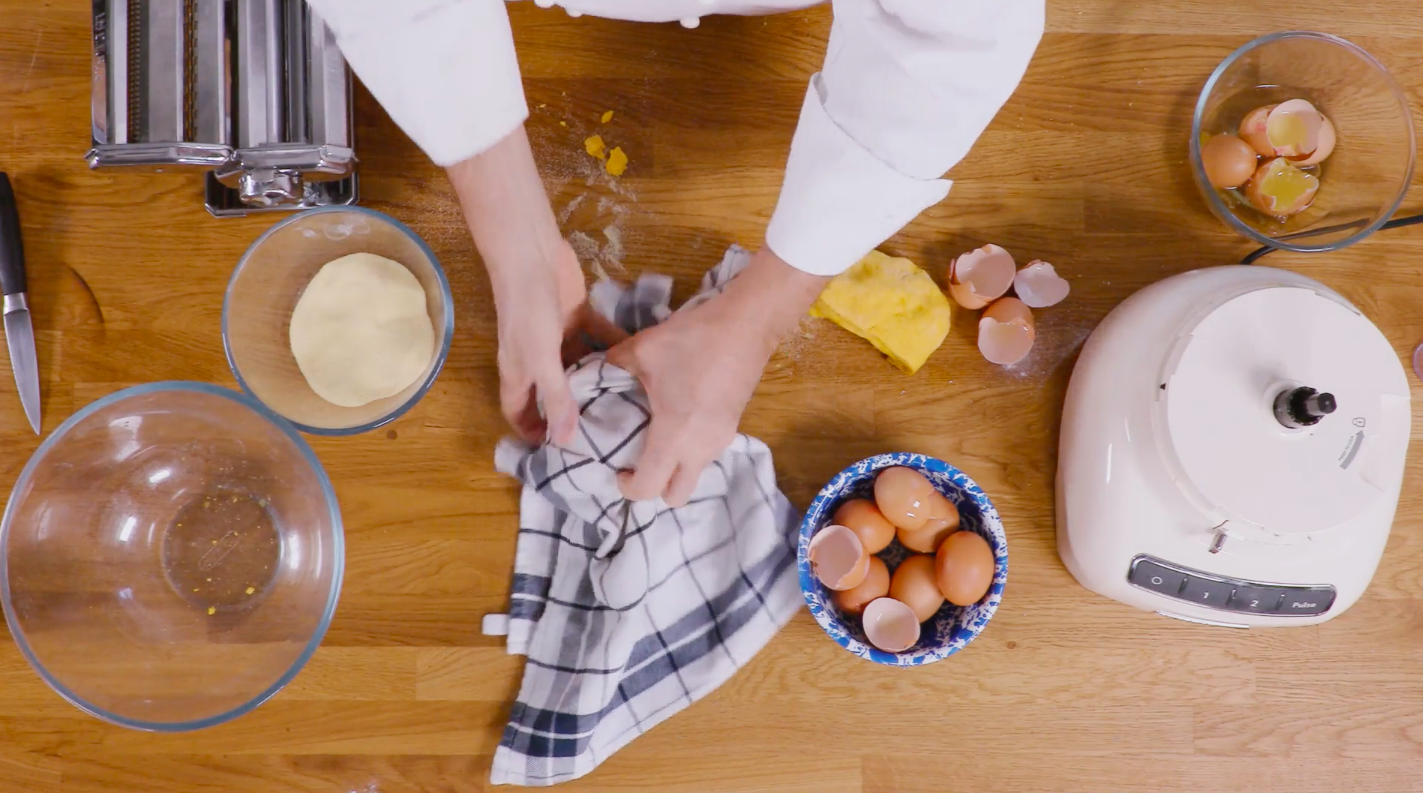
Wrap in cling film or cover with a damp towel. Leave to rest for twenty minutes
Step 5
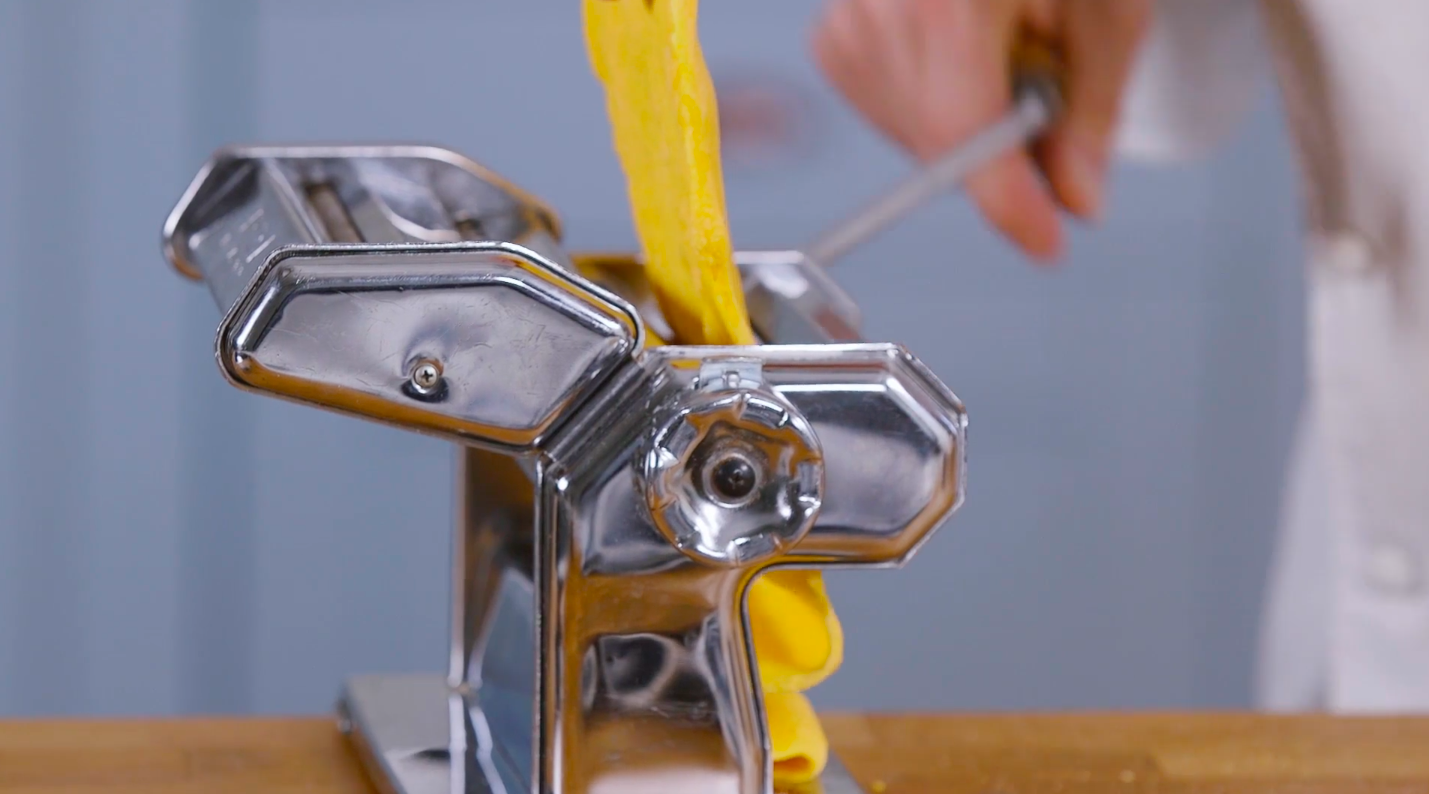
Flatten one ball of your dough into a rough rectangle. Feed through a pasta machine on the fattest setting about 4-6 times until smooth and elastic.
Step 6
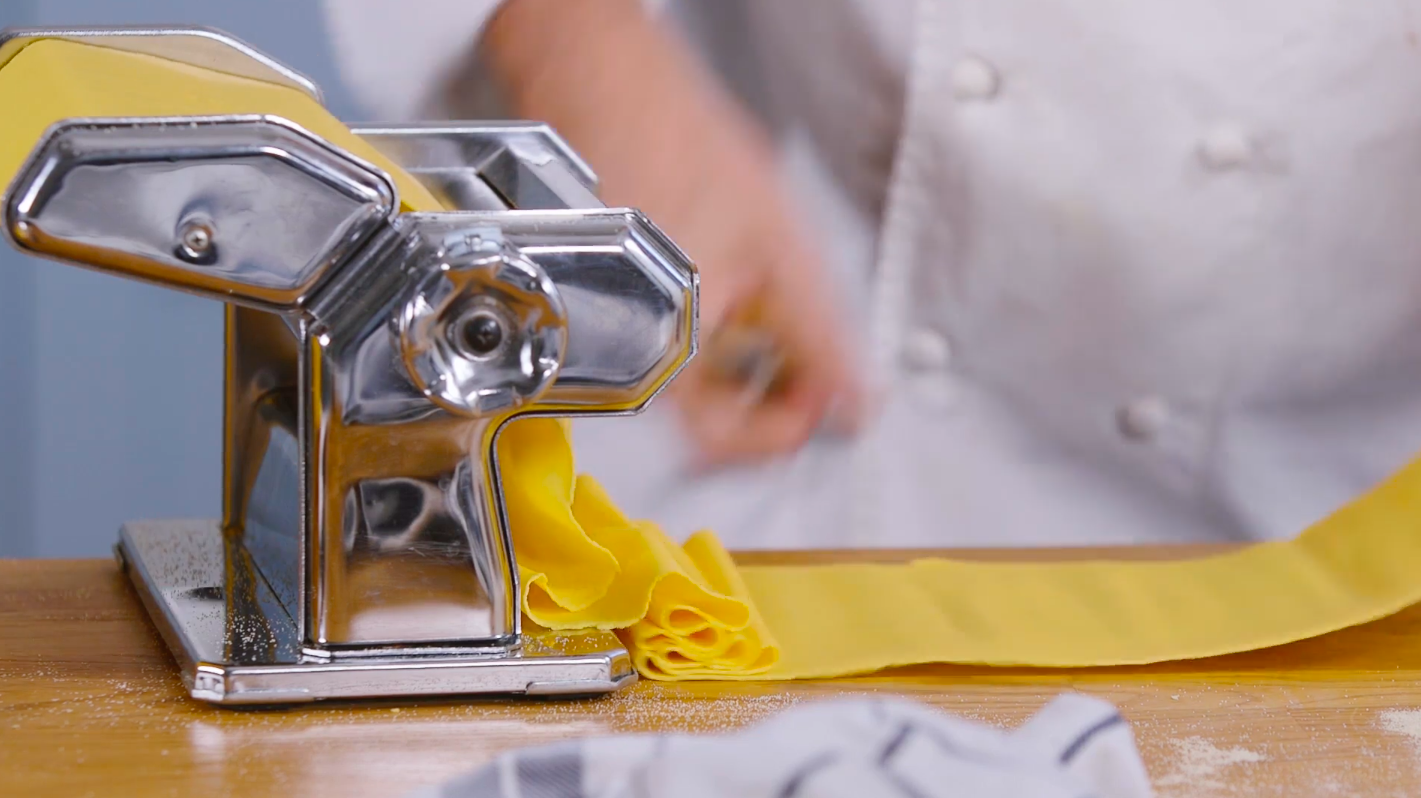
Next begin to work the pasta through the thinner settings, reducing it by one each time you feed the dough through.
When your pasta is thin enough you should be able to see your hand through the dough when you run the sheet of dough over your hand.
Step 7
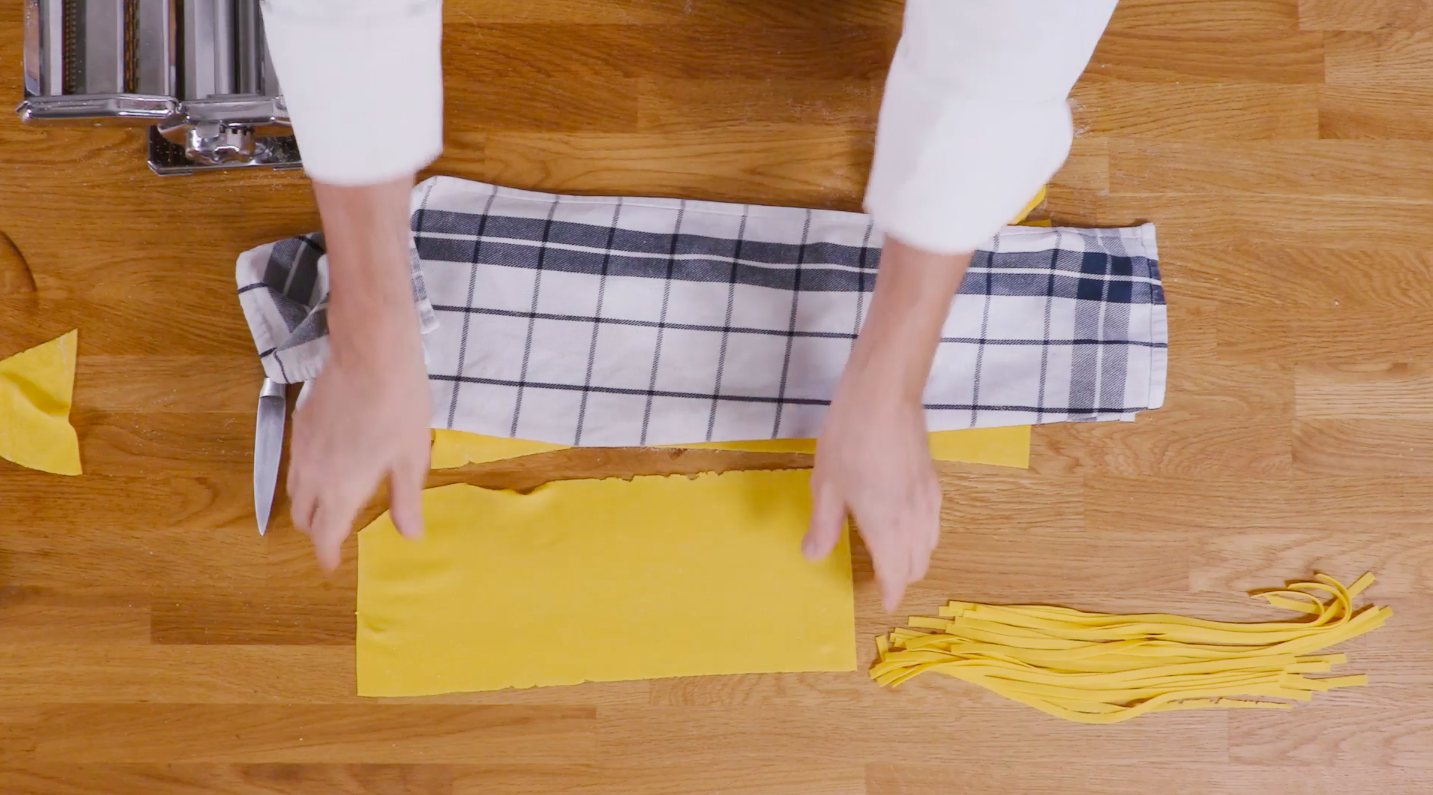
Cut the dough into long rectangles.
Step 8
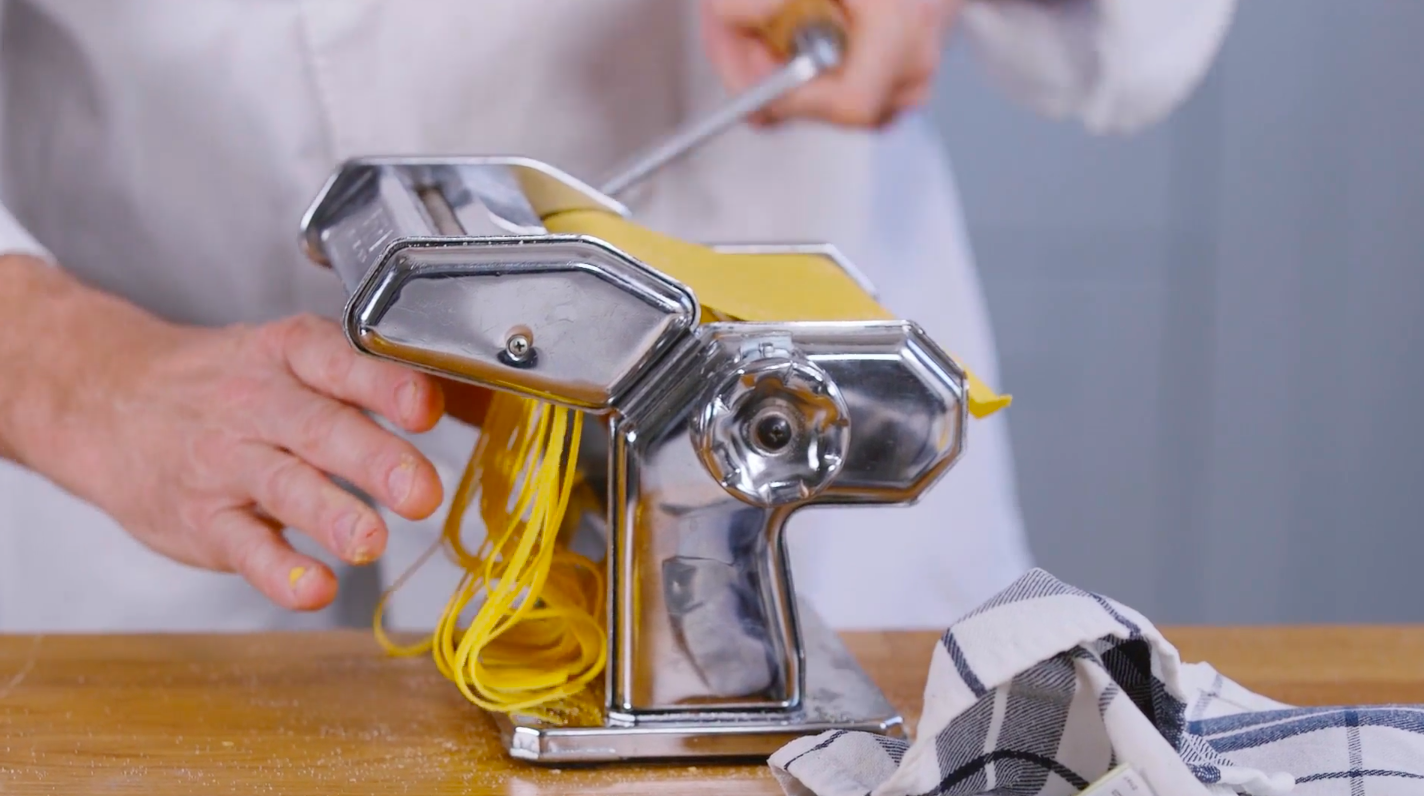
Using a pasta machine cutter, cut the strips into whichever size you prefer. You can also do this by hand, if you don't have a pasta machine. Dust with flour or semolina and leave to dry slightly for around twenty minutes before cooking.
Step 9
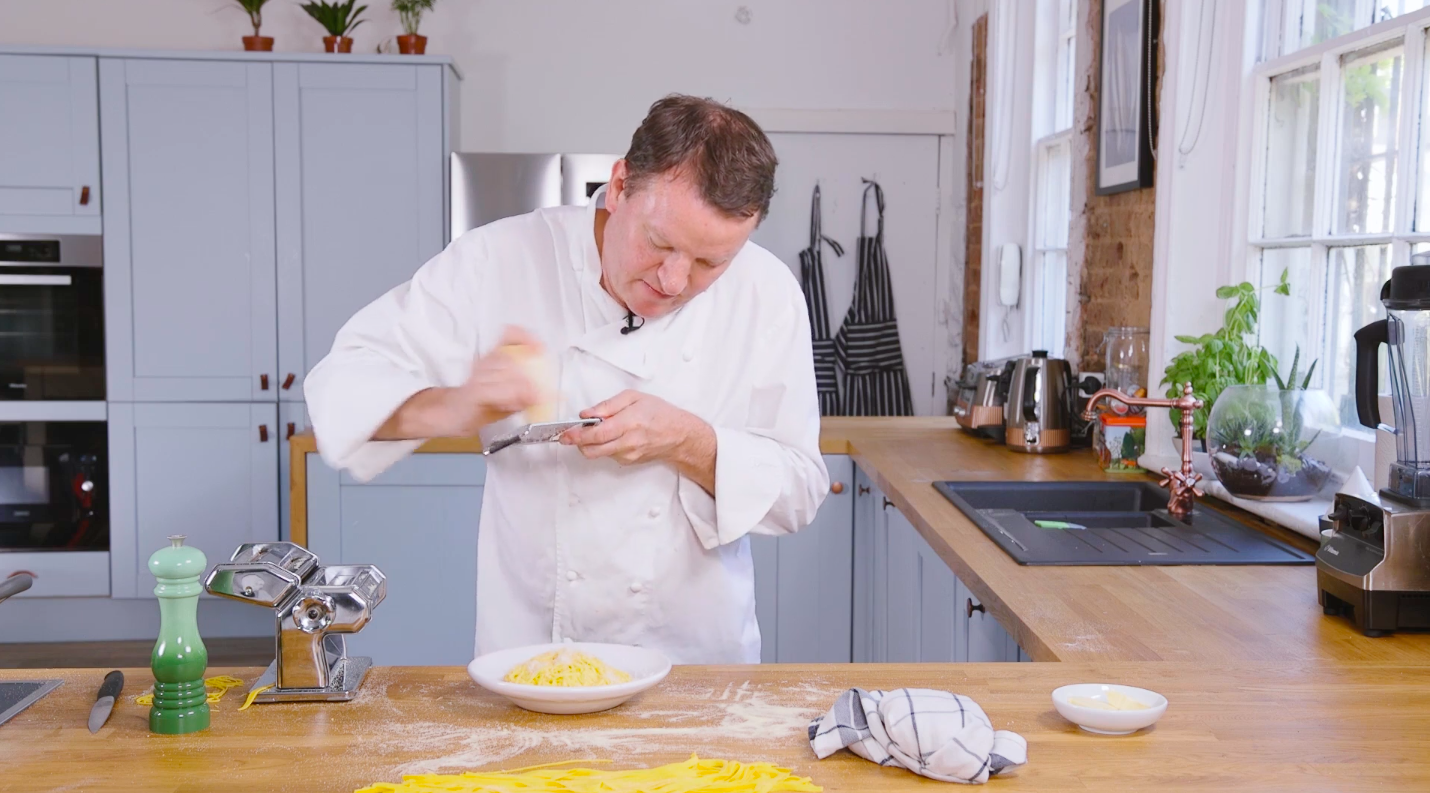
Cook the fresh pasta in boiling, salted water for 2-3 minutes. Serve with butter, black pepper and Parmesan, or the sauce of your choice.
FAQs about making fresh pasta
How to make pasta without a pasta machine
Although having a pasta machine will stand you in great stead should you regularly make pasta, you can also make it using just a rolling pin. To do this you will need to:
- Divide into 3 equal pieces to make this process more manageable.
- On a lightly floured surface, roll the dough into a rectangle. The size here depends on the quantity you’re rolling, but as a guide, let's say 30 cm by 15 cm. You want to roll the dough to the thickness of a £1 coin and then fold in half and roll again. Repeat this several times until you have a smooth sheet to work with.
- The thickness of the final roll will depend on what you’re planning to make, as there is no set guide for all pasta shapes. For something like pappardelle or tagliatelle, you want to roll the sheet nice and thin, around 2mm. Italians say that you should be able to read your newspaper through it, essentially. The sheet can become quite long, so cut into small sheets if necessary.
- Once at 2mm, or thereabouts, cut in sheets, around 20-25 cm. You can them like for lasagne, or loosely roll them up and cut them into strips.
- Cut 2 cm for pappardelle, 1 cm for tagliatelle, and around 2.5 mm for linguini.
Top tips for making pasta from scratch
There are a couple of rules to follow when making pasta, and if you stick to them, the process will run smoothly and be relatively stress-free.
- When rolling in a machine, don't force it. Let the machine do all the work and take your time. Run the dough through each setting a couple of times until you have your desired thickness. Don't try and speed things up by going from the thickest setting to the thinnest - all this will do is tear your pasta and you’ll have to start again.
- Be sure to place a slightly damp cloth or tea towel over the sheets until you are ready to work with them. They can become dry and break apart, and you don’t want that.
- Use a light dusting of flour when working with the dough, but refrain from using too much, as this can also dry out your pasta.
- When it comes to shaping, the sky really is the limit. You can experiment with different shapes and just let your creativity run wild. Here are a few of our favourites to start you on your way.
How to make homemade Fusilli al ferretto
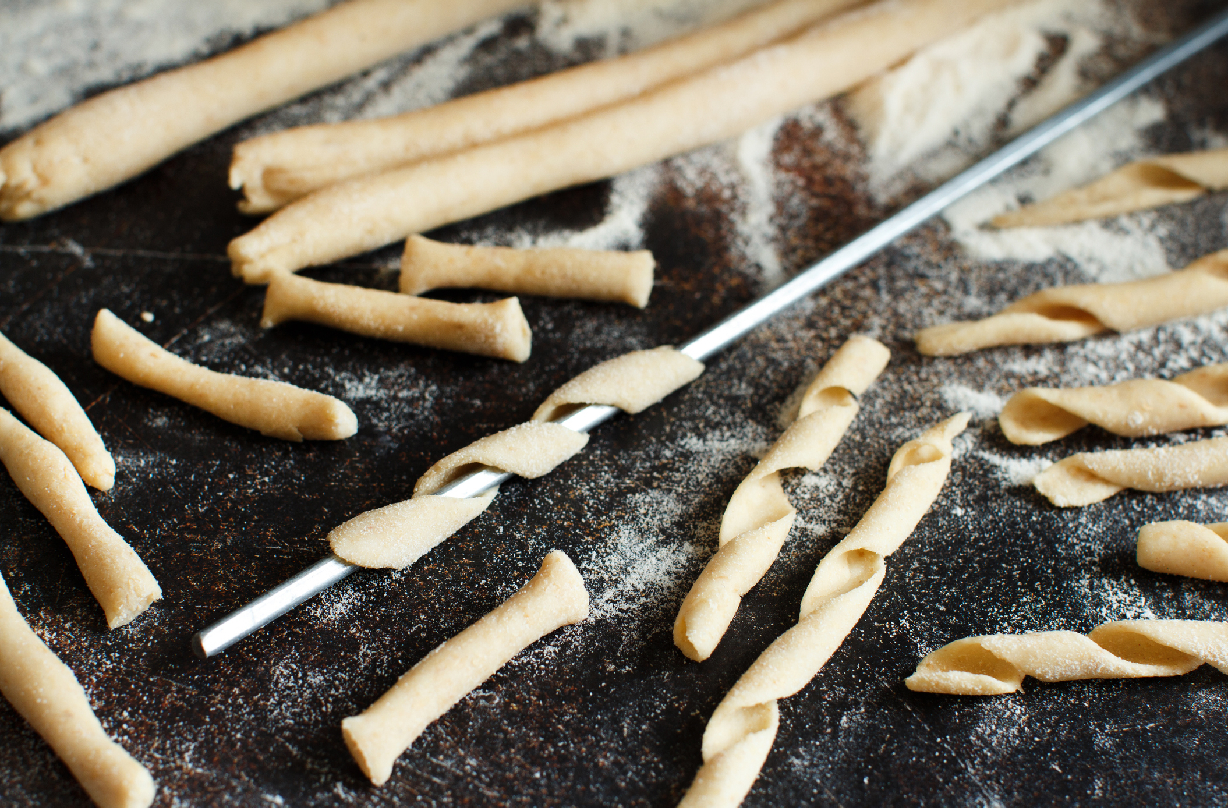
This is a shape most of us will recognise. It’s not exactly the same as the machine-made fusilli you can find in supermarkets, but a familiar iteration. The great thing about this shape is that you don't have to roll the dough in a machine, so it's a great one for beginners.
Take some of the dough and roll it into a long strip on the worktop; around the thickness pencil or a chopstick. Cut into lengths of around 5 cm and roll around a metal rod ‘ferretto’ starting from the one end and rolling to the other. You can use a kebab stick or wooden skewer for this also.
How to make homemade Orecchiette
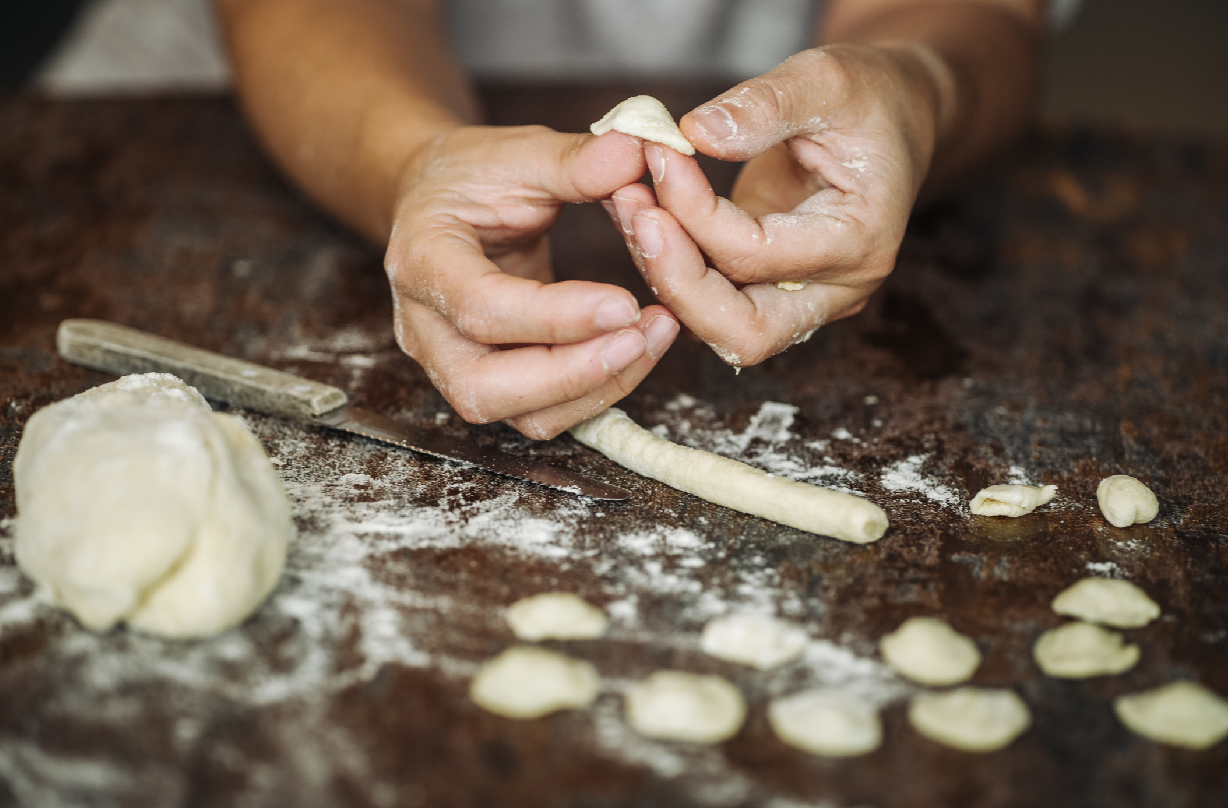
Orecchiette, meaning ‘“little ears’ is charming, and perfect for holding a lot of sauce. Just like Fusilli al ferretto, you don’t need a pasta machine.
- Take your dough and roll it into a long thin sausage shape.
- Cut bite-size pieces of the dough off of the end and, using a butter knife drag the blade over the pasta which will stretch the dough.
- Once stretched, overturn the pasta onto your thumb to create little cups, or ‘ears’.
How to make homemade Farfalle
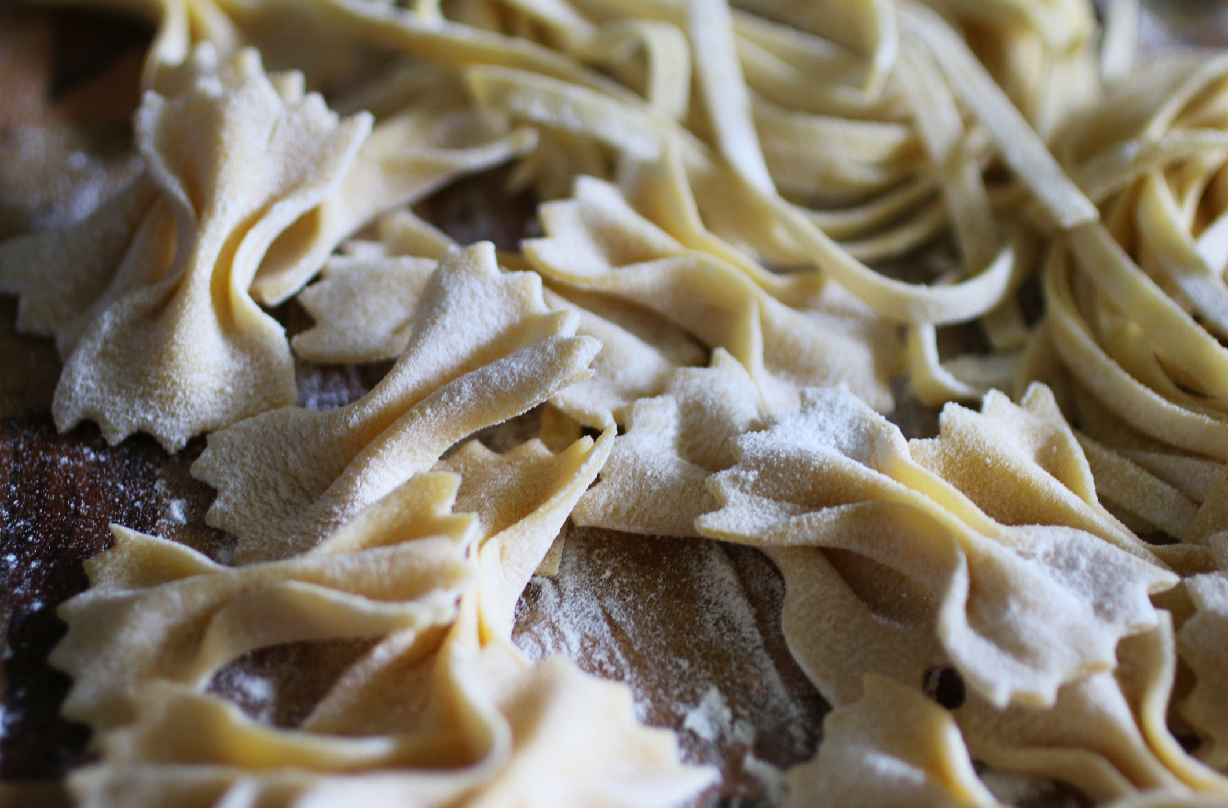
Farfalle is one of the most common shapes you will recognize, and though we usually refer to farfalle as ‘bowties’, they actually translate as “butterflies” in Italian.
This shape is a fun one for the kids to get involved with. To get the jagged edge synonymous with farfalle you will need a fluted pasta wheel.
- Using a pasta machine, roll the dough to 2mm, cut it into 2cm wide strips. Using the fluted pasta wheel, cut each strip into 4cm rectangles.
- To fold, you want to pick up the rectangle and fold it in half along the length.
- Pinch in the center at the base and then fold the edges back in the opposite direction and pinch again.
How to make homemade Tortellini
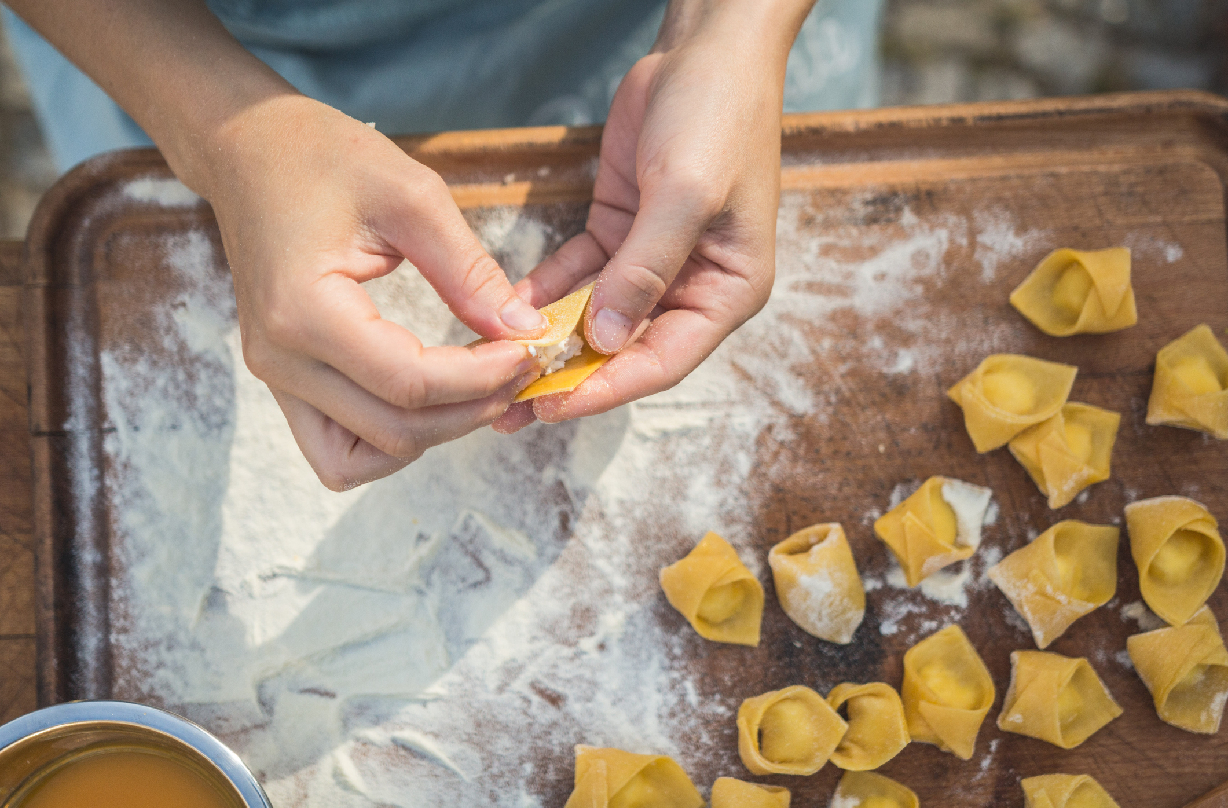
Tortellini is a stuffed, ring-shaped pasta from Bologna and Modena. Traditionally stuffed with a mix of pork, egg, and cheese, these are then served in a broth. You will now find tortellini stuffed with a variety of fillings and served in broth or sauces.
- Using a pasta machine, roll the dough to 2mm, cut it into 5cm squares. Tortellini shouldn't be too big, and the key here is not to overfill, otherwise, the filling will burst out and you’ll be left with a mess.
- Place a small penny-sized amount of filling in the center of each square. Pick up and form a triangle by pinching the top and bottom corners together and securing around the edges.
- Take the longest edge of the triangle (the edge you didn't pinch together) and work from one corner, wrap it around your index finger, pinching and securing it with the other corner. This one will take a few attempts, but once you hand the hang of it, they’re really impressive.
How to cook homemade pasta
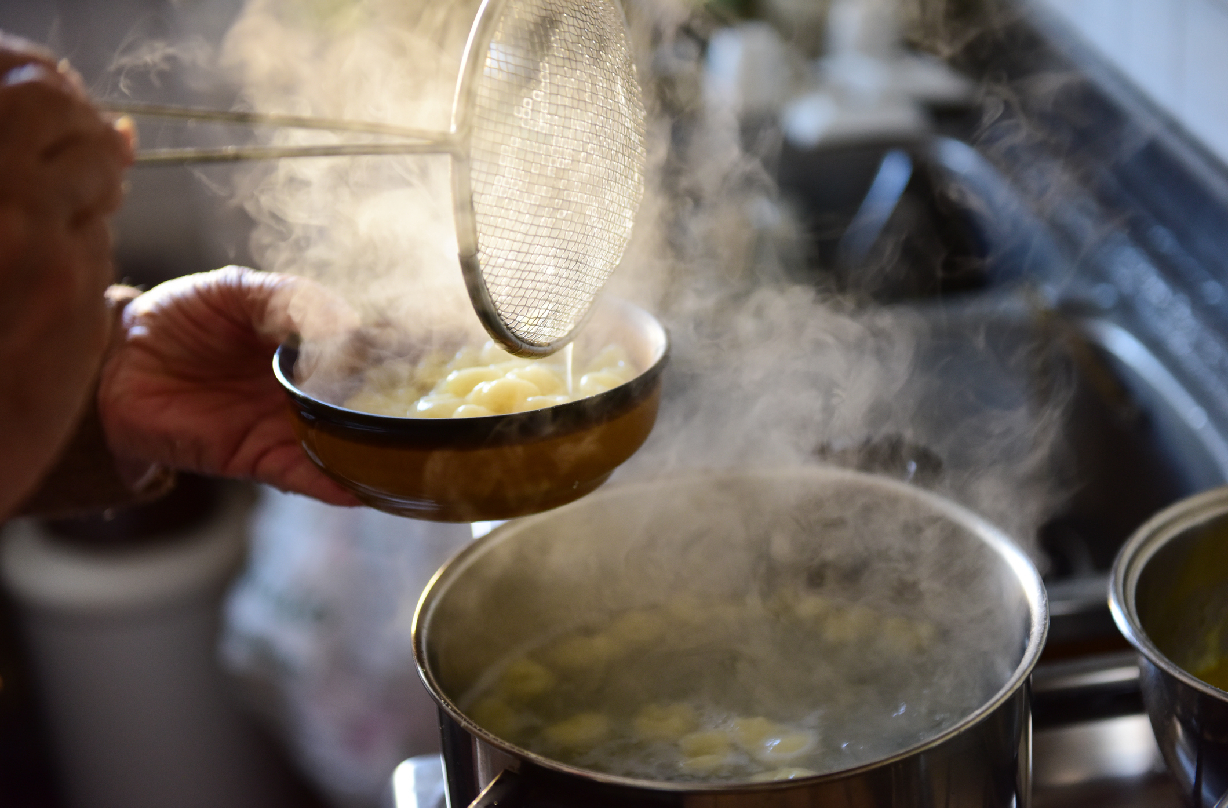
Don’t compare cooking fresh pasta with packaged dry pasta, they’re very different. Where the commercially made dried pasta may take 10-12 minutes to cook, fresh pasta only requires around 2-4 minutes to cook. This is also the case if you dry your own pasta, it still doesn't take as long as shop-bought dried pasta.
Bring a large pan of salted water to a rolling boil. Add pasta and, depending on the type of pasta you’re using, cook for 2-4 mins until the pasta floats to the top. Drain, add to sauce, and serve immediately.
For more of our top tips on how to cook pasta, see our handy guide, which includes how to cook dried, shop-bought pasta such as penne.
How to store homemade pasta
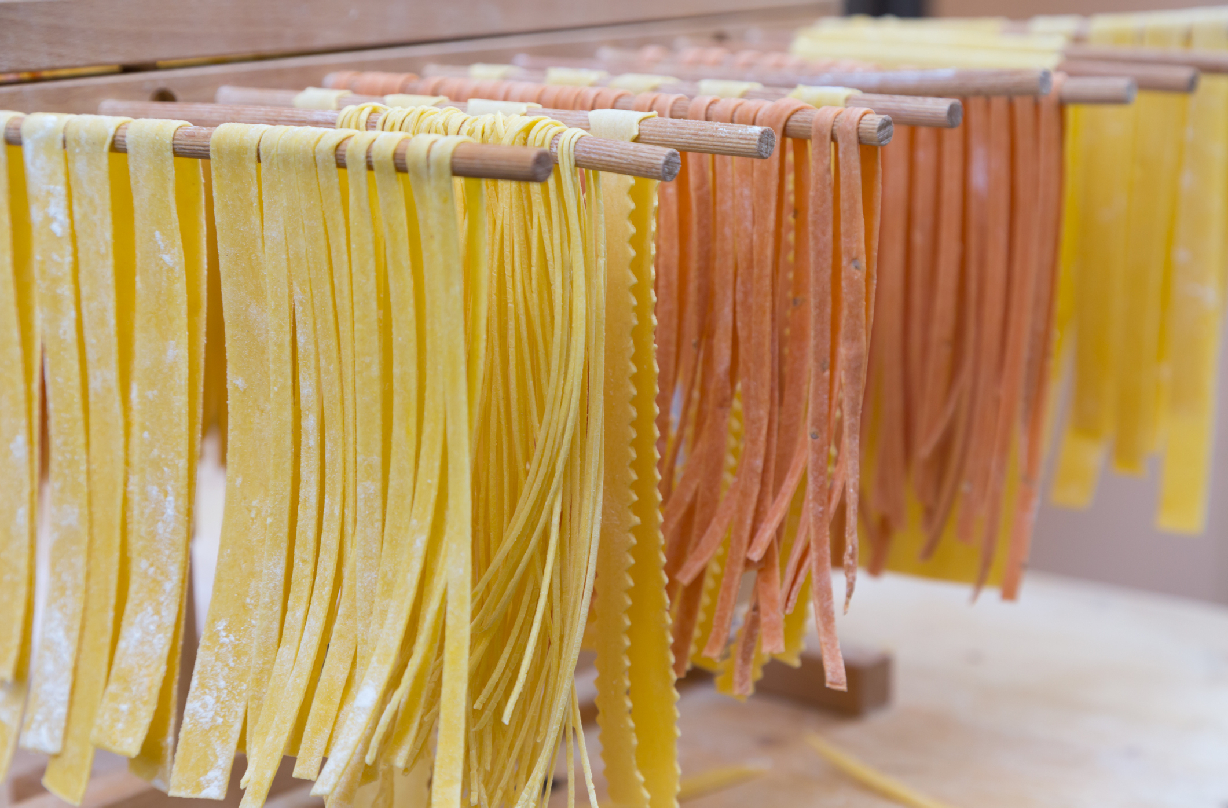
You can store the ball of dough wrapped in cling film in the fridge for up to three days. Once you have rolled and cut your pasta, dust in a little flour and store in airtight bags in the fridge for up to three days, or freeze for up to two months.
You can also dry out your pasta so you can store it for a longer period of time. Once you have cut the pasta into strips, drape each one over a pasta drying rack until crisp and brittle. You can also drape over the back of a chair, or a clothes horse, or on coat hangers if you don't have a pasta drying rack. Once dry, store in an airtight container for several months.
Best pasta making tools
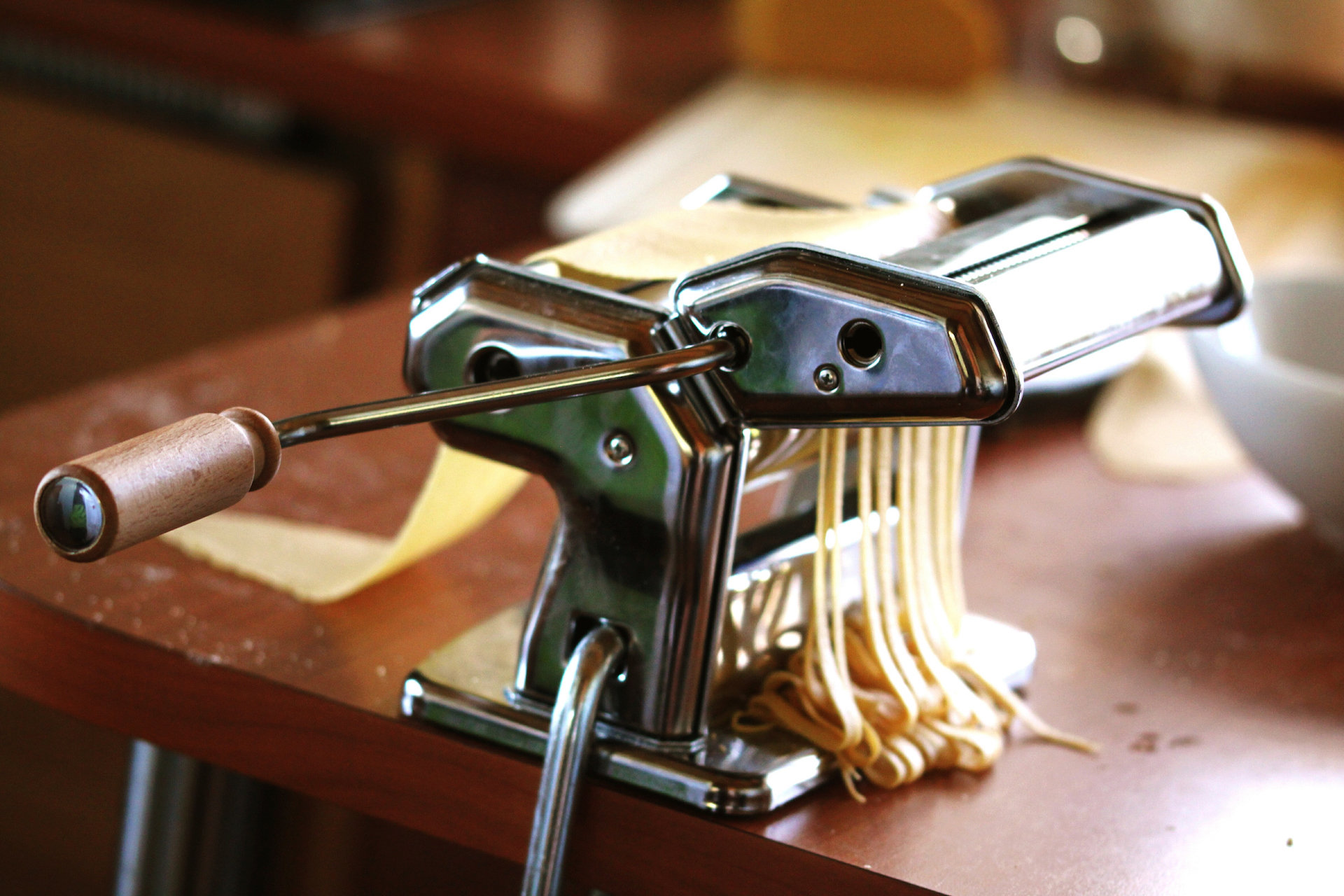
If you want to make your life a little easier by investing in some equipment, or you just want to experiment with some new gadgets, we've rounded up our favourite pasta tools just for you...
- VonShef Pasta Machine - VIEW AT VONHAUS | £29.99
- Lakeland 5-Piece Pasta Making Set - VIEW AT LAKELAND | £29.99
- Collapsible Pasta Drying Rack - VIEW AT LAKELAND | £15.99
- Gnocchi/Pasta Ridger - VIEW AT SOUS CHEF | £4.49
- Delihom Pasta Maker - Stainless Steel Pasta Machine - VIEW AT AMAZON | £154.99
Our best fresh pasta recipes
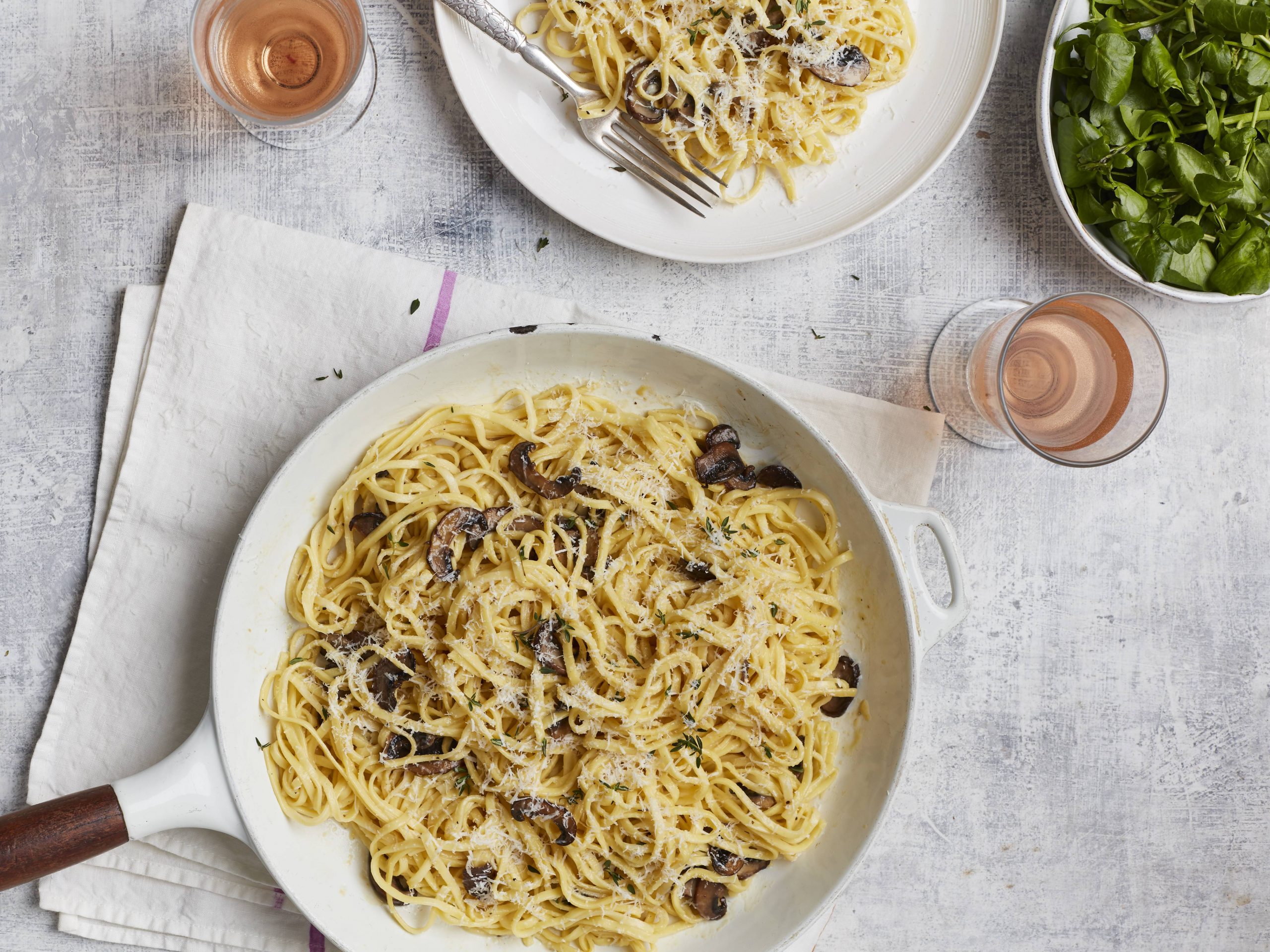
1. Vegetarian spaghetti carbonara with smoked cheese
This carbonara uses fresh tagliatelle and is on the table in less than 15 minutes. Loved by vegetarians and meat-lovers alike; the smoked cheese and the bite from the mushrooms is a wonderful replacement for pancetta. Serves four.
Get the recipe: Vegetarian spaghetti carbonara with smoked cheese
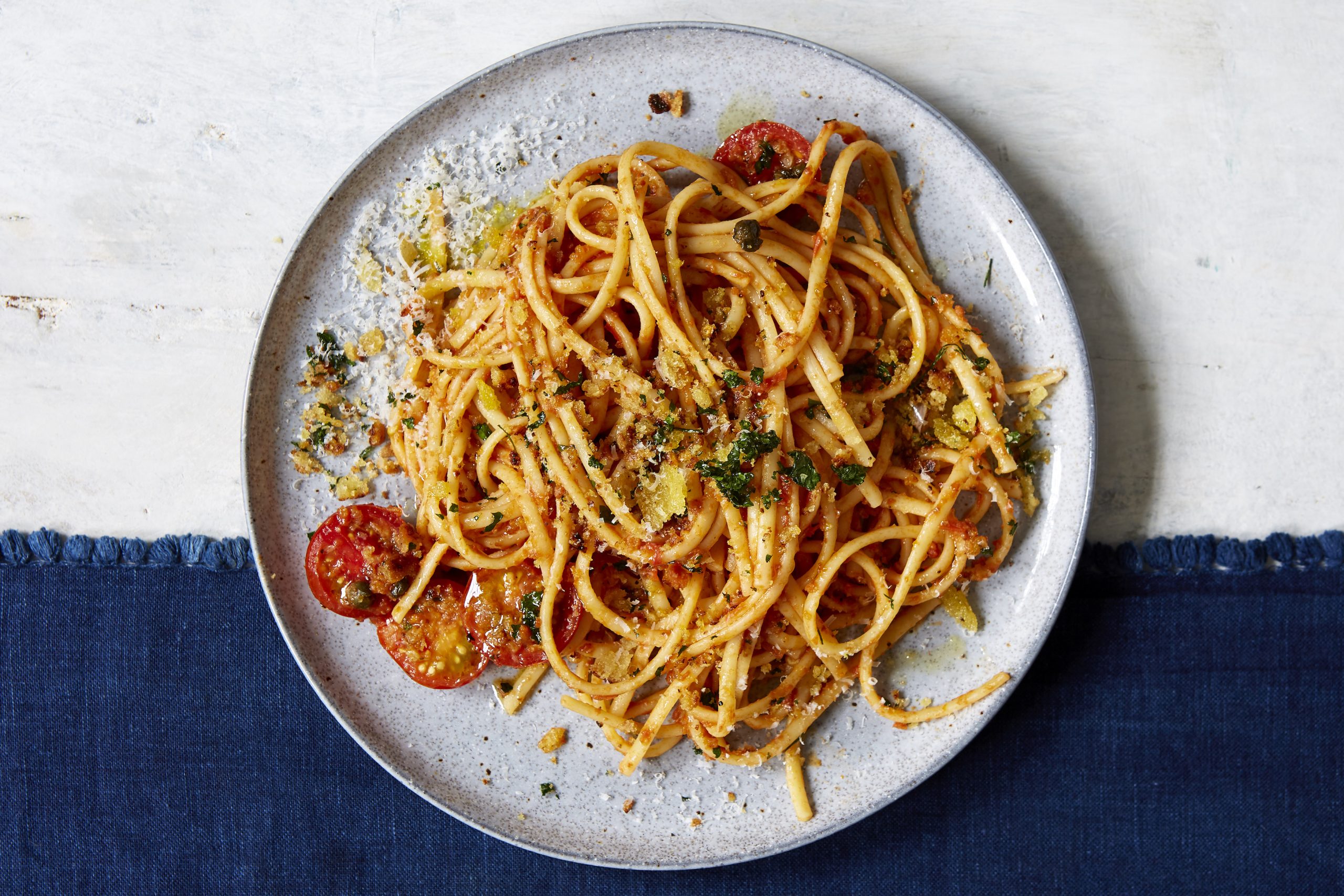
2. Anchovy pasta with crispy breadcrumbs
We've used linguine to make this speedy midweek meal. Sweet tomatoes paired with salty anchovies make for a very satisfying supper, and the breadcrumbs add a lovely texture. You can use fresh or dried linguine, just adjust the cooking times accordingly.
Get the recipe: Anchovy pasta with crispy breadcrumbs
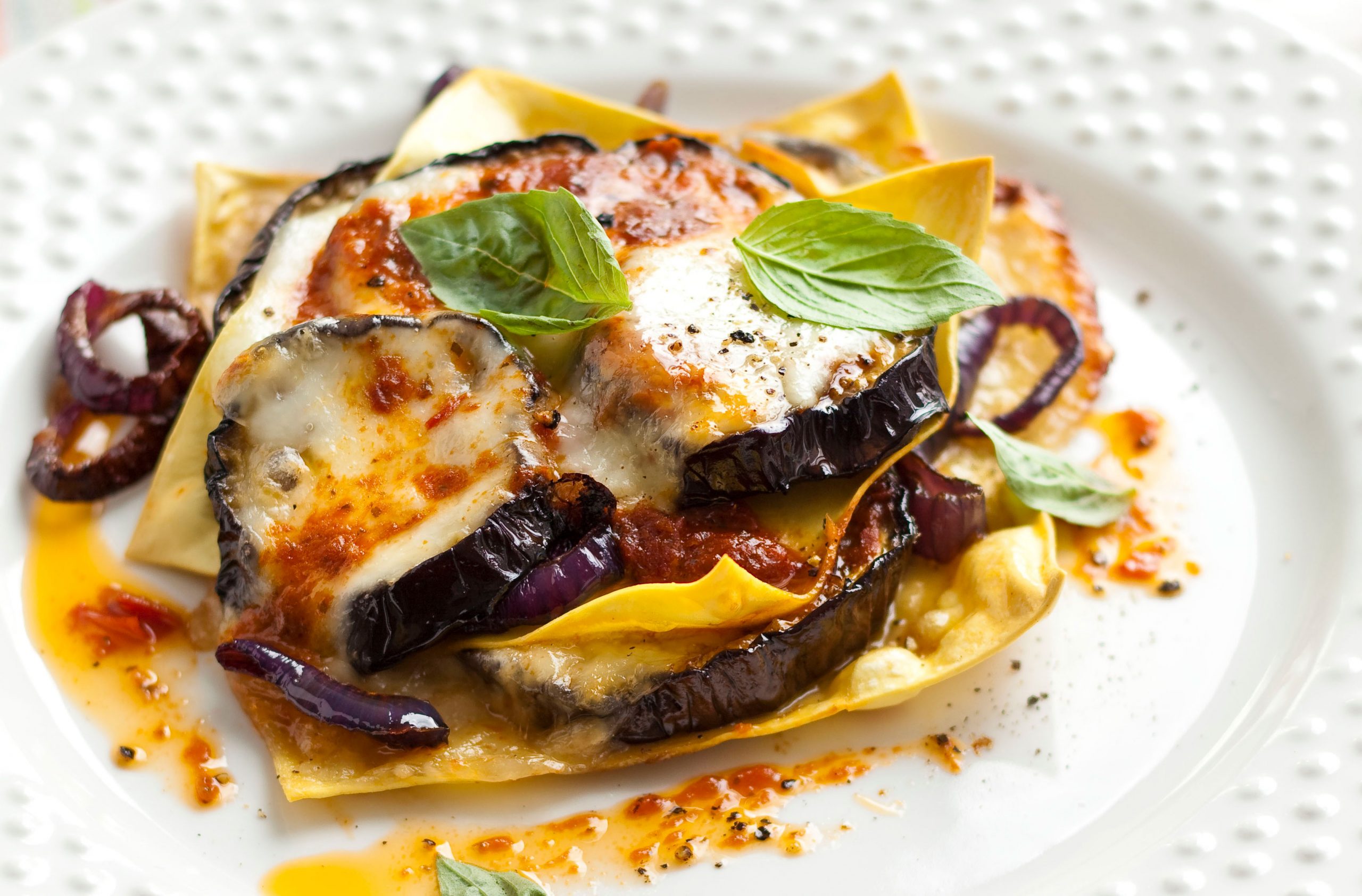
3. Open Mediterranean lasagne
If you don't like waiting for lasagne to come out of the oven, you can try out the shortcut Med-Style open lasagne - it's ready in less than half the time and tastes just as delicious.
Get the recipe: Open Mediterranean lasagne
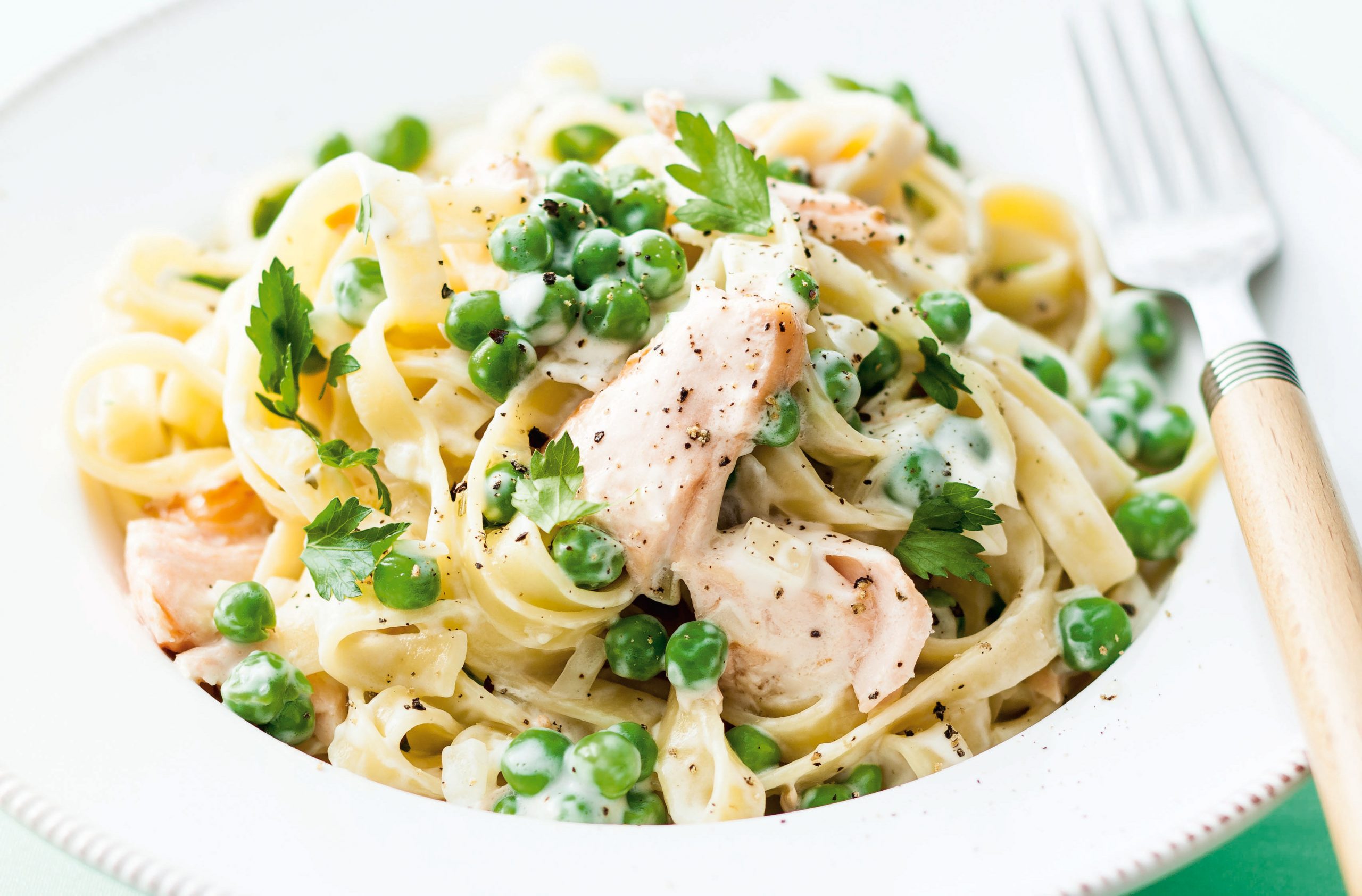
4. Creamy salmon tagliatelle
This fresh tagliatelle dish is perfect for when you're craving something creamy and indulgent. With chunks for beautifully tender salmon, it's a real crowd-pleaser. Serves four.
Get the recipe: Creamy salmon tagliatelle
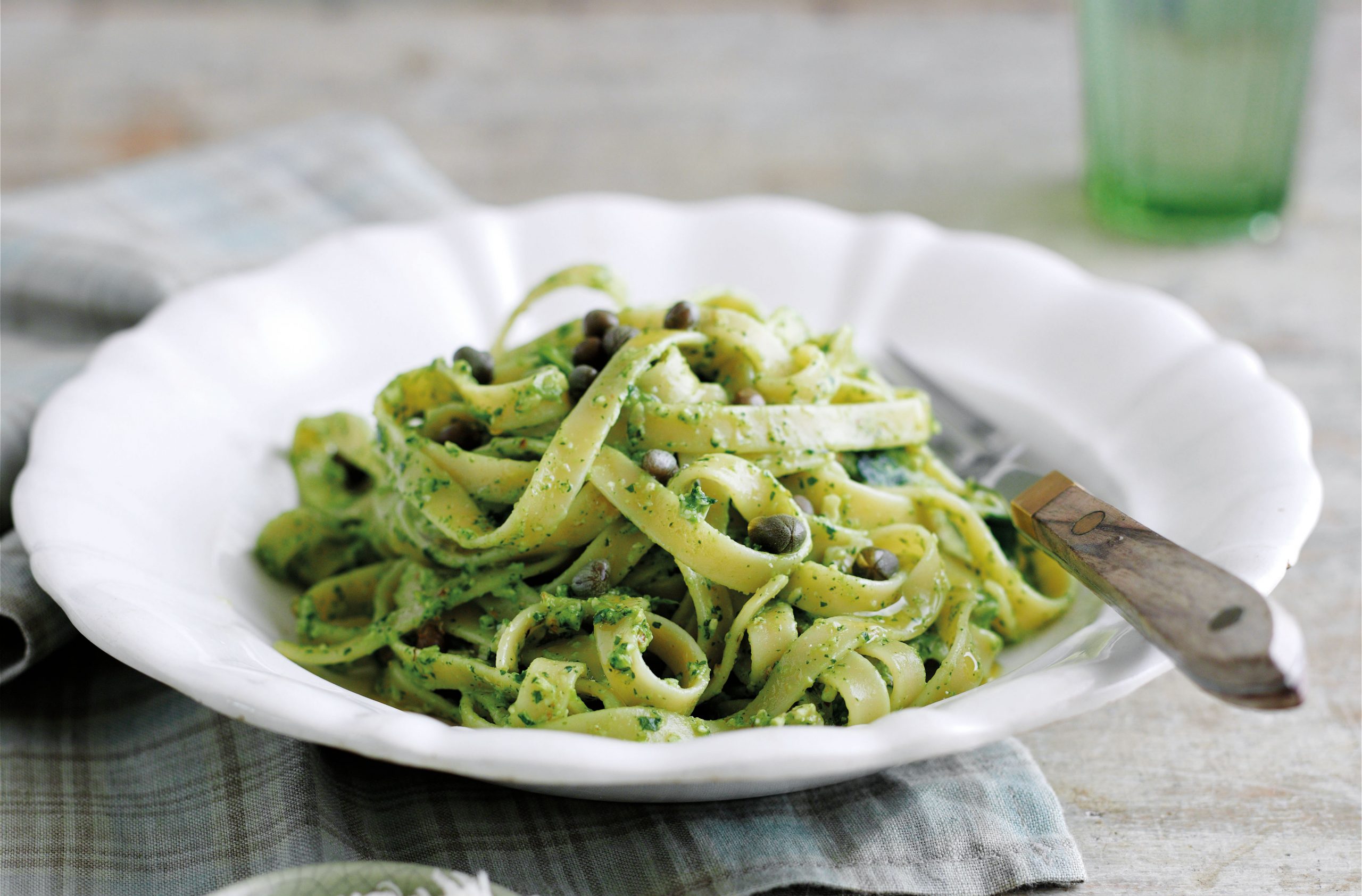
4. Watercress and walnut pesto with pasta
Pasta and pesto are the perfect matches. We've paired this fresh tagliatelle with fresh homemade watercress pesto, and it's so much easier than you may think. Ready in just 15 minutes.
Get the recipe: Watercress and walnut pesto with pasta
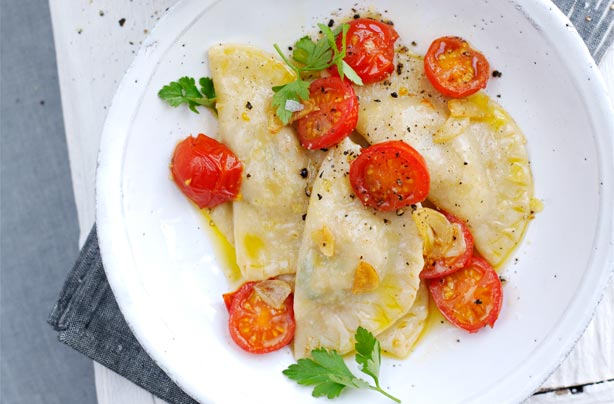
5. Crab ravioli
This is the dish to make when you want to seriously impress. Everyone thinks ravioli is extremely difficult to make, but our crab ravioli is super easy. Full of beautiful fresh crabmeat and a subtle kick of spice. We would recommend serving with a chilled glass of Chenin Blanc.
Get the recipe: Crab ravioli
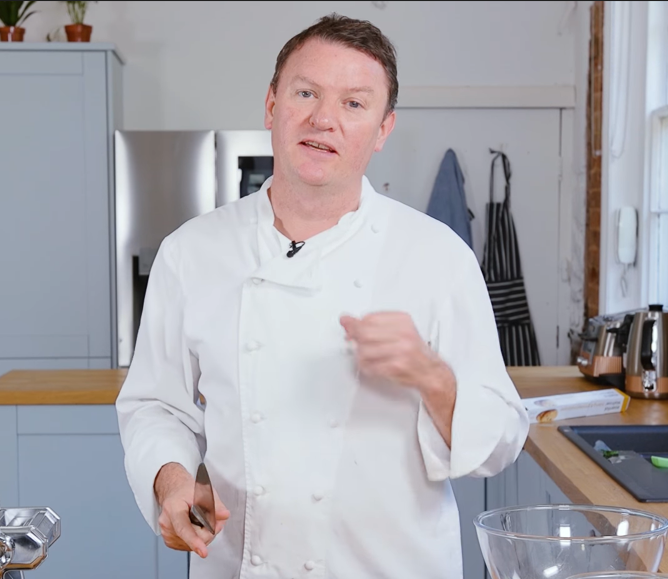
Theo Randall is a well-known Michelin-star chef who regularly appears on BBC One's Saturday Kitchen as well as an author publishing four successful recipe books including Pasta (2006), My Simple Italian (2015), and The Italian Deli Cookbook (2021), and The Italian Pantry (2022). His passion for food started from a young age when on his family holidays in Europe, where he became inspired by the European way of cooking and dishes and knew a culinary career was destined for him. His career began working as a waiter at Chez Max and after only a few weeks was asked by Max Magarian to work in his kitchen where he spent four years training in classic French cuisine. Then by 1989, Theo joined River Cafe and soon became head chef and under his patronage, it received its first Michelin star. He then went on to launch InterContinental in 2006 delivering delicious rustic Italian food in his prestigious location of No.1 Park Lane. Despite Theo's success, you will find him at most services at the InterContinental.
Related Features:
How to make tomato pasta sauce with Theo Randall
How to make ravioli with Theo Randall
How to make risotto Milanese with Alberto Rossetti

With over 12 years of experience, arts graduate Keiron turned to food to channel his creativity, specifically cake decorating. Keiron set up his wedding cake business in 2015. And, in late 2016 won a scholarship at the world-renowned culinary institute - Le Cordon Bleu, London, where he studied the art of French Pâtisserie. He's worked in some of London’s finest 5-star hotels, collecting a wealth of knowledge along the way. As a Food Writer and Stylist food isn’t just a job, it truly is Keiron's passion.
- Christina GeggusJunior Food Writer